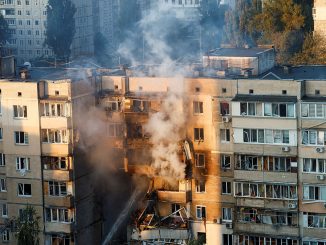
| Published June 18, 2025
Moscow’s drone strikes have grown exponentially in part because of a deal with Iran to produce its Shahed drones in Russia; overnight attack leaves 15 dead
Russia’s war in Ukraine has entered a new phase—one dominated by the mass deployment of attack drones. Thanks to technology transfers from Iran and accelerated domestic production, Russia is now flooding Ukrainian skies with thousands of explosive-laden unmanned aircraft every month. These drone swarms aren’t just a tactical nuisance—they’re reshaping the battlefield, targeting Ukraine’s power grid, cultural landmarks, and air defenses in what experts describe as a relentless, low-cost, high-impact strategy. As both sides intensify drone operations, the skies over Eastern Europe are becoming the central front in a new kind of warfare: automated, precise, and increasingly hard to stop.
🇷🇺 Russia’s Drone Explosion
-
Mass production after Iran deal: Since a late‑2022 agreement with Iran, Russia acquired Shahed drone tech and massively ramped up local manufacturing—no longer dependent on imports.
-
Industrial scaling: Open-source investigators (Center for Information Resilience) report over 20,000 attack and decoy drones launched by Russia so far in 2025—a volume that once took months to reach is now deployed every two weeks
🎯 Tactical Shifts on Ukrainian Frontlines
-
Saturation strikes: Russia employs waves of inexpensive drones to overwhelm Ukraine’s air defenses, causing both civilian damage and psychological strain .
-
High-frequency relentless attacks: For example, on June 10, nearly 315 drones and 7 missiles struck Kyiv, damaging historical sites like Saint Sophia Cathedral and key infrastructure.
⚔️ Strategic Impetus & Aftershocks
-
Retaliation narrative: Moscow claims these drone waves are responses to Ukraine’s Operation Spider’s Web, a deep‑strike drone operation that damaged Russian strategic bombers inside Russia.
-
Escalation of air‑war doctrine: Putin has ordered rapid development of a dedicated drone force, creating the Russian Unmanned Systems Forces expected to number over 210,000 personnel by 2030.
🔄 Ukraine’s Counterpunches
-
Precision drone raids: Ukraine’s own Operation Spider’s Web saw more than 100 low‑cost drones infiltrate deep into Russian territory, reportedly hitting some 40 strategic bombers, highlighting that drones now serve as both offensive and defensive tools.
-
War of attrition at low cost: Experts note these operations represent “precise mass”—cheap, effective drone strikes that upend the traditional military balance .
🌍 Broader Implications & Future Outlook
-
Strategic Tilt Toward Russia
Russia’s ability to mass-produce attack drones gives it a persistent offensive advantage. These drones, though relatively low-tech, are overwhelming Ukraine’s expensive Western-supplied air defenses, forcing Kyiv to burn through limited missile inventories just to intercept cheap flying bombs. -
Air Defense Fatigue
Ukraine’s reliance on high-cost systems like NASAMS and Patriots to intercept low-cost drones is economically unsustainable. This mismatch accelerates Ukraine’s defense exhaustion and exposes vulnerabilities in urban and critical infrastructure zones. -
Psychological & Civilian Strain
Daily drone raids—especially at night—are taking a toll on Ukrainian morale. Constant blackouts, sleepless nights, and sporadic infrastructure failures are chipping away at civilian resilience and raising the risk of internal displacement. -
Drone Arms Race
Both sides are in an escalating drone war. Ukraine’s long-range drone attacks deep into Russia, such as the strikes on strategic bomber airfields, show that the drone war isn’t one-sided. But Russia’s industrial scale gives it the upper hand for now. -
Global Security Precedent
Russia’s adaptation of Iranian drone tech and its transformation into a scalable domestic model signals a warning to NATO and other nations: the battlefield is being redefined by affordability, mass production, and AI-guided autonomy—forcing militaries worldwide to rethink their defense postures.
🧠 Overall Takeaway:
The war in Ukraine is entering a new era—defined not by tanks or missiles alone, but by relentless waves of low-cost, mass-produced drones. Russia’s industrial-scale drone production, fueled by Iranian technology and domestic scaling, is giving it a strategic edge by wearing down Ukraine’s air defenses and disrupting civilian life. While Ukraine has responded with creative, long-range drone raids, it remains outpaced in sheer volume and sustainability.
The conflict is no longer just a conventional ground war—it’s become a high-stakes tech and logistics battle where innovation, supply chains, and endurance determine who dominates the skies. Unless Ukraine secures scalable, cost-effective air-defense solutions soon, Russia’s drone advantage could tip the long-term balance of power.
SOURCES: THE WALL STREET JOURNAL – Russia Is Churning Out Attack Drones. Ukraine Is Feeling the Impact.





Be the first to comment